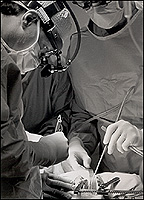For the past 18 years, CTVS surgeons, known for their valvular work, have led the south United States in number of Ross procedures performed with over 350 completed to date. They have performed the Ross procedure since 1990 and have a mortality rate of less then 3%. CTVS surgeons were first in the world to perform a Ross procedure for endocarditis (infection of the heart valve) with 100% cure rate. Retired cardiac surgeon and past president of CTVS, John Oswalt, MD, was the first surgeon in Texas to perform the Ross Procedure. Dr. Oswalt has traveled extensively throughout the United States and Europe, training surgeons on the Ross procedure. He has also served as faculty on surgical symposia, teaching the implantation of the homograft and the Ross procedure.
What is the history of the Ross procedure?
Dr. Donald Ross, an accomplished surgeon in London, was a pioneer of the aortic valve replacement using the human homograft. This later evolved into what we now call the Ross Procedure which uses a cryopreserved valve (homograft) and the patient’s own valve (Autograft). The procedure was first performed in 1967. In 1987, Dr. Ross presented his 20-year results, which were overwhelmingly good and met with much enthusiasm in US.
What does the Ross procedure involve?
The Ross procedure is a special procedure that uses the patient’s own pulmonary valve to replace the diseased aortic valve. The patient’s pulmonary valve is replaced with a cryopreserved cadaveric pulmonary valve. The longevity of the valve is superior to that of other biologic valves and there is no need for anticoagulation. (View a detailed drawing: “What happens during a Ross procedure?“)
What devices are used during the Ross procedure?
The Ross procedure is done using cardiopulmonary bypass, which allows the surgeon to stop the heart and still continue to perfuse the body with oxygenated blood.
Who is the ideal candidate for the Ross procedure?
As the durability of this operation becomes evident, the age range for patients undergoing the Ross procedure is expanding. It is now considered a long-lasting solution to infants with congenital aortic stenosis because it very possibly eliminates the need for multiple valve surgeries. Older patients with more active lifestyles are also now considered candidates for this procedure. Women of childbearing age are certainly candidates because there is no need for anticoagulation which can cause many complications during a pregnancy. Together with the fact that the autograft has performed well with high levels of activity and there is no need for anticoagulation, athletes are also candidates for this procedure.
Who should not have the Ross procedure?

Patients with coronary artery disease should not have this procedure due to the complexity of combining coronary artery bypass with the Ross procedure. In addition, patients who must be on anticoagulation for other medical reasons should not have this procedure nor should patients with connective tissue disorders, Marfan’s syndrome, or Rheumatoid disease of the valve. These disease processes effect the viability of the pulmonary valve (autograft).
What are the advantages of the Ross procedure?
The success rate is an impressive 98% survival rate at CTVS. A low percentage of patients have required a re-operation for valve repair and enjoyed freedom from anticoagulation with its yearly risks. The autograft performing as naturally as the aortic valve is an additional advantage.
What are the disadvantages of the Ross procedure?
The major disadvantage of this procedure is that it is a very technically demanding to replace two valves instead of one. Experience plays a large part in having success.
What is the length of stay for this procedure?
Average length of stay is 4-5 days
How do I find a surgeon who performs Ross procedures?
Your cardiologist will be your first line of information. They should know a heart surgeon who does the Ross procedure or know a surgeon to recommend. Thorough research will benefit you in your selection. You should look for a surgeon who has performed at least 100 Ross procedures and a hospital that performs 300-500 open heart operations per year. The mortality rate for the Ross procedure should be less than 5%.
Ross Procedure Specialists

